Transcending Barriers
A Behind-the-Scenes Conversation on the Making of Rare Earth
Jacqueline Chao, Dennis Kratz, Robert J. Stern, and Robert Lavinsky
Rare Earth: The Art and Science of Chinese Stones, recently on view at the Crow Museum of Asian Art of The University of Texas at Dallas, explores the different ways that Chinese and Western cultures have celebrated the beauty found in, and created from, natural stones. Reflecting the educational mission of The University of Texas at Dallas to unite scientific and artistic thinking, the exhibition pairs works of Chinese art from the Crow Museum’s permanent collection with connoisseur-level samples of raw minerals from China. It uniquely displays these natural and reshaped minerals in contexts that invite multiple, interrelated responses: to appreciate their beauty, ponder their cultural significance, and be inspired to understand the natural forces that created them.
Collecting rocks and stone carvings has been popular in many countries, but particularly in Chinese culture for thousands of years. This tradition is rooted in the philosophical and spiritual inspiration drawn from the artistic beauty of natural stones, such as jade. Unusually-shaped stones called “Scholar’s Rocks” or “Philosopher’s Stones” carved by natural processes have also been long valued in China in particular, where there is a multibillion dollar market in such stones. Seen as embodiments of the dynamic transformational processes of nature, these stones were also admired for their resemblance to mountains or caves, particularly the magical peaks and subterranean paradises believed to be inhabited by immortal beings (Figure 1). Although mineral collecting, a practice based on the aesthetic appreciation or the scientific characteristics of the naturally symmetric and patterned crystals and minerals that make up rocks, has a long history in the United States and in Europe since the 1300s, it was not commonly practiced in China. The country’s abundant mineral resources were, instead, historically used as raw material for both art and industrial purposes only. In the mid-1980s, this changed when remarkable Chinese specimens entered the Western market, not only amazing collectors worldwide, but also stimulating a rising interest within China to collect fine minerals.
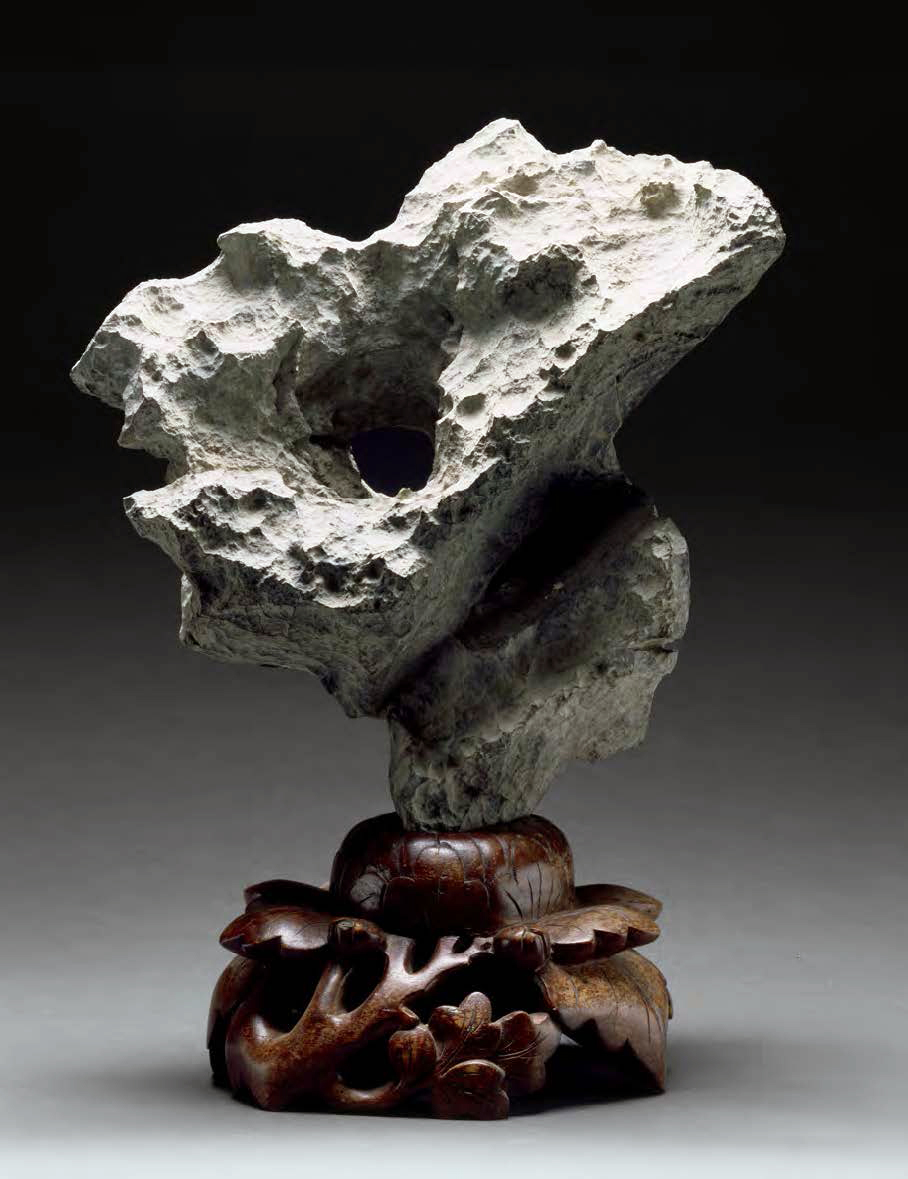
Crow Museum of Asian Art of The University of Texas at Dallas, 1986.25.
This exhibition was co-organized by the Crow Museum of Asian Art of The University of Texas at Dallas and the Center for Asian Studies of The University of Texas at Dallas, in partnership with the UT Dallas Department of Geosciences and the Dr. Robert Lavinsky Mineral Collection.
On the occasion and as a reflection of the collaborative spirit of the exhibition, we wanted to provide an honest behind-the-scenes look at how the exhibition came to be amongst the organizers—from the selection of objects, to the various discussions, debates, arguments, and ensuing discoveries. In this conversation are Jacqueline Chao, former Senior Curator of Asian Art of the Crow Museum and curator of the exhibition; Dennis Kratz, Senior Associate Provost and Director of the Center for Asian Studies at UT Dallas; Robert J. Stern, Professor of Geosciences at UT Dallas; and Robert Lavinsky, lifelong fine mineral collector and educator.
How did this exhibition come to be?
Jacqueline Chao (JC): I have known Rob Lavinsky for several years now, and a few years ago I and several members of the Crow Museum’s staff had visited the Arkenstone Gallery, to see Rob’s mineral collection. I remember that I was blown away by the size and scale of his collection, which included minerals from all over the world, along with a particular special private area of the collection dedicated to minerals from China, many types and samples of which I had never heard of, or ever seen before. In those early visits, many years ago, Rob and I discussed what an art exhibition could look like that blended aspects of Chinese art and culture with natural minerals. Also at the time, we had been in communication with the Perot Museum of Nature and Science, as they were in the process of re-installing their Gems and Minerals Hall with a focus on minerals from China, and our two museum teams had met to see if there was a way to possibly collaborate on the timing of both our exhibitions. With our Museum’s subsequent merger with UT Dallas and the ensuing pandemic, all of our Museum’s plans were delayed. I am grateful to Dr. Kratz for having helped to pick this conversation back up again last year through the Center for Asian Studies (CAS) Faculty Advisory Board, and for reconnecting me with Rob (Lavinsky) as well as introducing me to Bob (Dr. Stern).
Dennis Kratz (DK): As I recall, the project slowly emerged from a series of conversations involving various combinations of the four partners. For me, it began with a tour of the Arkenstone Gallery and a conversation with Rob about our shared interest in connecting science with art—for him, using art to attract students to scientific thinking; for me, merging scientific, artistic, and humanistic thinking in education. Subsequent conversations with Bob Stern and Jacqueline Chao—and I assume their conversations with one another and Rob—inevitably developed the idea of connections; and Jacqueline had an impressive ability to translate this generative concept into the form of an exhibition.
Robert Stern (RS): I have been on the UT Dallas Geosciences faculty for 40 years. In that time I have seen amazing growth at UT Dallas. We have added so many groups of people with a wide range of talents, certainly new degree programs, departments and schools but also things like the Center for Asian Studies (CAS) and the Crow Museum of Asian Art.
I am increasingly concerned that UT Dallas’s growth has not been matched by efforts to link these groups together, and to involve our students and communities in more of our activities. Nearing the end of my career, I enjoy trying to help build some of these connections and getting involved with CAS provides a great opportunity to do so. I also enjoy working on new projects, like CAS and Athenaeum Review, because the ground rules for these babies are still flexible, encouraging innovation and experimentation. When CAS formed, I was interested to help involve science in its purview and reached out to Dennis, who was kind enough to invite me to join the CAS faculty advisory board. I was very happy to join because I am very interested in Asian geology and resources, partly because I am a geologist and understanding how Asia and its important mineral resources formed is very interesting, and partly because I am Editor-in-Chief of a journal, International Geology Review, which gets a lot of manuscripts about Chinese geology. I knew about Rob Lavinsky’s world-class mineral gallery, the Arkenstone, and also have been a big fan of the Crow Museum for many years before it became part of UT Dallas. Before the covid pandemic, Dennis was looking for ideas about how CAS could announce itself to the larger DFW community and, as I recall, I suggested that we somehow marry the Chinese art in the Crow with the Chinese minerals in Rob’s collection.
Rob and Jacqueline did the heavy lifting to make it happen.
In your own words, how would you describe your role in this project? What was your approach? What were your main concerns regarding this project, if any?
JC: My role, at least as I understood it, was to curate the exhibition, particularly the Chinese art works on view. I worked closely with Rob to identify particular mineral examples from his Chinese mineral collection, and we continued to adjust the list of mineral samples right up until beginning the exhibition installation.
My main concern and approach was to make sure that Chinese art and culture was presented authentically and respectfully, and also that the mineral examples were being presented authentically and respectfully as well. My first idea was to create thoughtful and intentional pairings of like object and mineral, where each case would showcase a particular mineral. However, when reviewing the museum’s Chinese art collection, it became clear that I did not necessarily always have certain minerals represented in works of art, because those minerals were not used as the base for Chinese art production historically. While minerals such as gold and silver were more easily represented and could be thoughtfully paired with existing works from the museum’s permanent collection, other minerals such as hemimorphite or aragonite had not been traditionally used for art production, instead having been more often used historically for industrial purposes. I was faced with a conundrum: how do I showcase these fantastic natural mineral examples, while still making a respectful and authentic connection to Chinese art and culture?
After several rounds of case mock-ups and thoughtful discussion, I proposed taking what I called “aesthetic leaps” in thinking about the display of certain artworks and certain minerals. For example, I paired the hemimorphite “cloud” and aragonite “tree” with our Duan stone table screen to highlight the landscape motifs of the screen. I placed the large pink Pyrite on Calcite (Figure 2) on its own in one case, and in its object label, I connected it to the tree peony, discussed the significance of the peony flower in Chinese art and culture, and so on and so forth. I wanted to allow visitors to the exhibition to be able to participate in creating the story of these objects in a way, and to be able to make these aesthetic connections on their own, in order to appreciate each work, whether a piece from the museum’s collection, or a stunning natural mineral example. Every conversation with Dennis, Bob, and Rob was incredibly helpful. Both Bob and Rob were especially helpful in drafting more detailed scientific explanations for each mineral, which I think was critical in cementing the collaborative theme of science and art in this show.
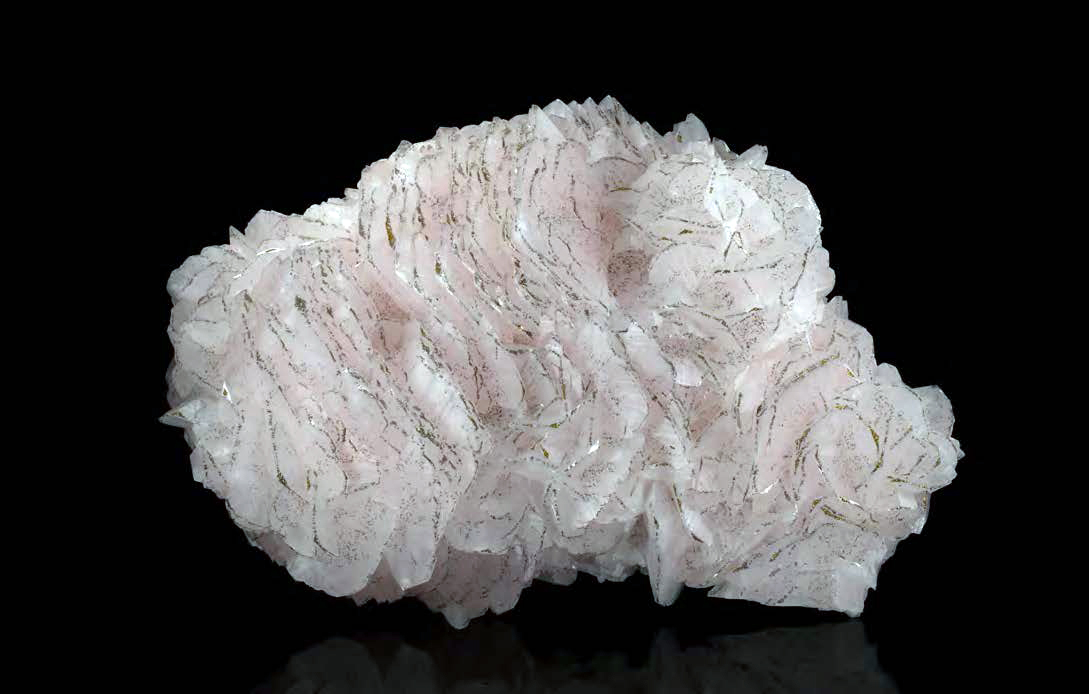
DK: My role (at least as I imagined it) was to keep the exhibition focused on the process of thinking that the objects on display inspired. At the time, I was involved in a cross-centuries conversation with Alexander von Humboldt. I had just finished reading a biography (The Invention of Nature by Andrea Wulf) and was in the midst of Cosmos, Humboldt’s grand attempt both to describe the natural world as a living whole, all its parts inextricably and intricately interconnected, and to show that a full understanding of nature required the fusion of intellect and imagination. I wanted the exhibition to evoke a similar kind of “interconnected” response.
The decision to juxtapose “natural” and human-sculpted pieces was a brilliant start. It wouldn’t be enough, however, simply for a science-minded observer to see beauty, or for an artful-minded observer just to become more interested in the natural processes that created the minerals on display. Somehow, I hoped, some observers would become participants in seeing and imagining multiple kinds of connections between works displayed side-by-side and among works displayed separately.
RS: I helped with the original idea, and also provided some explanations for various minerals. I knew from many years of teaching at UT Dallas that the equally intelligent Chinese art history and mineral communities were equally knowledgeable of their own field and equally ignorant of the other, so the explanations of various minerals in the displays needed to be short, simple, and without too many unnecessary details. I really had no concerns about the project.
Rob Lavinsky (RL): Minerals, crystals, and beautifully shaped rock formations have a profound place of honor as treasured objects in many human cultures and in the art they create. We’re used to seeing human creations that owe their coloring to these raw, natural minerals in carvings, jewelry, and paintings. In Western culture, historically, we have tended to focus less on appreciating their natural forms. In Asian cultures, there is a particularly strong cultural relevance to displaying naturally-shaped stones as art objects with imbued cultural meanings to enhance the home and even health. This rising trend in popular culture is now fusing with the longstanding tradition of Americans and Europeans curating focused mineral collections. We’re proud to develop this cooperative effort between the Crow Museum of Asian Art, UT Dallas, and my own collection to share the unbelievable natural beauty, history, and cultural relevance of these natural works of art in synergy, blurring the lines between the seemingly separate worlds in how we classify nature, science, and art. My hope for this exhibition is to show people the unbelievable, and collectible, beauty within the earth, which is just now gaining a new level of awareness and appreciation. I have collected minerals all my life, since I first saw these treasures as a child, and it is my belief that through telling stories of connections to culture and art, people will see these objects in new eyes, not as reductionist “rocks on a shelf” as if the same objects were in a science museum.
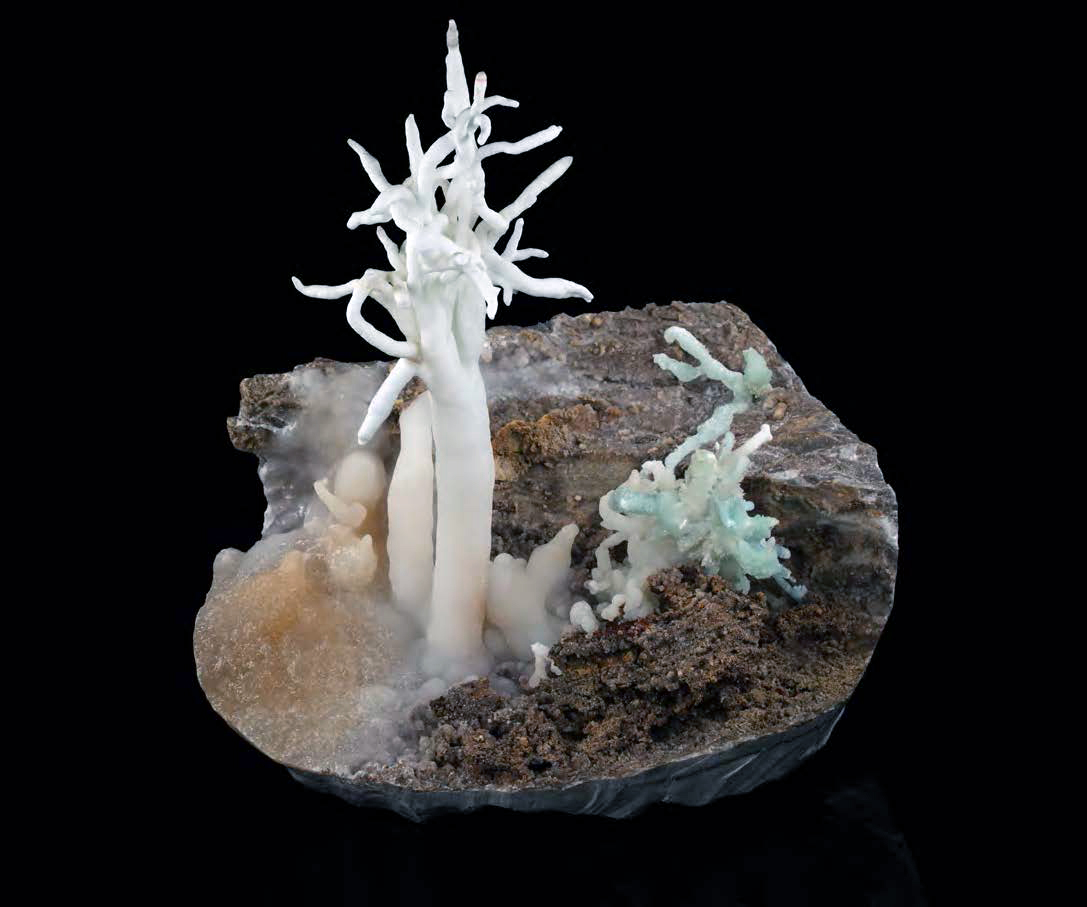
Were there things that happened in the process of planning this exhibition that surprised you? What was something new you discovered?
DK: Not so much as surprised by how much I learned from listening to the multi-perspective conversations among my three colleagues—especially Jacqueline’s process of juxtaposing pieces and creating the possibility of connections among distantly placed objects.
RS: I knew Chinese carvings of jade but was very surprised to learn that these incredible artists also carved quartz crystals.
JC: Echoing what Dr. Stern said earlier, I admit I am one of those art historians who did not have a very strong scientific knowledge of minerals going into this project. As a result, there were many discussions and debates that occurred during the planning of this exhibition that surprised me. For example, the question was raised about whether to include jade in the exhibition, as jade is not considered a mineral! I had always understood jade to be a mineral, and it was difficult to imagine this exhibition without including fine examples of Chinese jade carving, perhaps the largest and most important aspect of our museum’s Chinese collection. I was conscious of being careful to not misrepresent the various mineral examples either. From these conversations, I realized it was important and necessary to expand the scope of the show to include a broader discussion on the appreciation of stones in Chinese culture, from Scholar’s Rocks to other stones such as marble or soapstone—stones that are not technically classified as minerals, but rather, as metamorphic rocks. I think by expanding the scope of the exhibition to include the celebration of stones in Chinese art and culture in general, which includes gems and minerals, we were able to create a more rich and innovative presentation of these works. In the end, I am grateful for this wonderful partnership, the invigorating conversations, and everything that I have learned from this project.
RL: First, letting go of my traditional ways of viewing minerals—even though I see beyond, I am still constrained by the past—and letting Jacqueline go with it and make the selections herself…had a huge impact and change from what I might have picked, and yet I love them all. Secondly, the idea of less is more—this is not a science museum. We do not need quantity to convey impact, only quality and the right story.
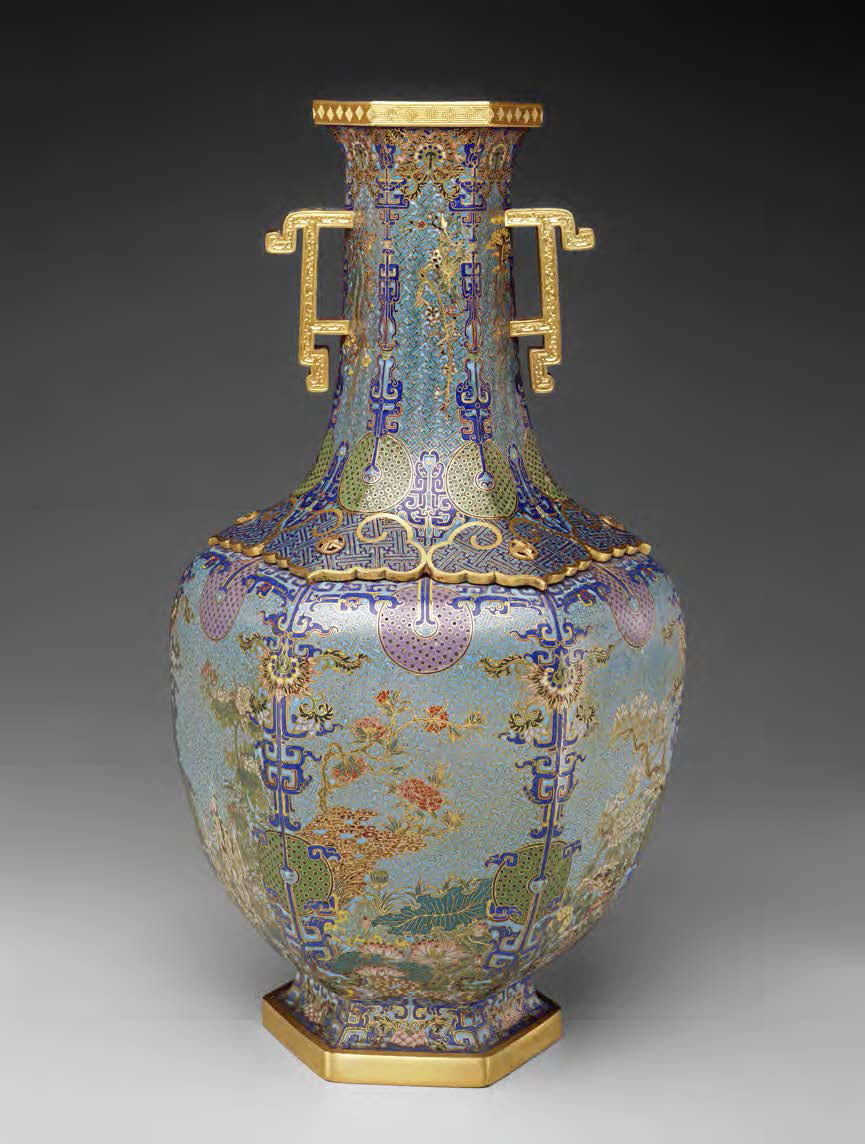
What is your favorite piece in the show, and why?
DK: Two “pink” flowers sculpted by nature (a large pink manganoan calcite, and two flowers formed by calcite on calcite). During a visit by the Chinese Consul General, I was showing the First Secretary (Lian Shuyu) the exhibit and pointed out the two flowers. Her response was immediate—and from a wholly different emotional perspective: Pink is her daughter’s favorite color. We then searched out other pieces mainly or just tinged with pink, while talking about our families, and reminding me of other ways that works of art—natural and human made—have the power to remind individuals from different cultures of our common humanity.
RS: I have five favorites: The scholar’s rock (Figure 1), the pyrite turtle, the chrysanthemum stone, the tunnel rock, the big blanket, and a carved quartz vase. The Scholar’s Rock captures a sensibility that doesn’t exist in the West. These are natural pieces of limestone that were first fractured into vertical slabs and exposed to the elements, which over thousands of years were slowly carved by slightly acid rainwater into ruggedly intricate shapes. These are found wherever limestone landscapes are fractured, uplifted, and exposed. Such landscapes are called karst, and the spectacular karstic limestone landscapes of Yunnan, southwest China, are famous; this is probably the region that many Scholars Rocks come from. Among the carved pieces, I very much admire the quartz pieces, especially the quartz vase. Quartz has a Mohs scale hardness of 7, and I can’t imagine the skill and patience it took to carve those!
I also like four natural pieces that make you stop and ask: Is that natural or carved? These are the pyrite concretion (turtle), the slab of yellow sandstone laced by iron oxide to resemble a tunnelscape, the big black slab of limestone with white “Chrysanthemums” of the mineral celestine, and the pink manganoan carbonate edged with pyrite (big blanket). The first three of these are the result of subsurface chemical reactions that geologists call diagenesis. Diagenesis involves the physical and chemical changes that happen to sediments underground as they transform into sedimentary rock. Diagenesis happens in many ways and these three objects show three of them: 1) forming concretions (the turtle); 2) infiltrating chemical-laden fluids (lacy sandstone tunnel); and 3) growing new minerals (Chrysanthemums).
The turtle concretion is exquisite; its rounded body is permeated with pyrite crystals marking original sedimentary bedding planes. Concretions form in sediments after they are buried, as diagenetic chemical reactions begin to cement the loose grains, beginning from some nucleus and expanding outward, so that concretions are typically sub-spherical, like a turtle’s shell.
The big slab of sandstone laced with iron oxides is also a product of diagenesis. I got lost imagining myself going down this crenulated tunnel. This slab seems to have been cut out of a larger stone and polished. The lacy crenulations of reddish iron oxide formed when iron-rich fluids infiltrated the sandstone. The chrysanthemum rock is a black shale in which diagenesis sweated elements of strontium, sulfur, and oxygen to migrate slowly out of the surrounding rock and combine to form clusters of large celestine (strontium sulfate) crystals, radiating from a few nuclei thought to be caused by sulfur-rich bacteria trapped in the rock. The effect is stunning, with a few big white Chrysanthemum blossoms set against a jet-black background. The last of my favorite five is big blanket. This beauty has many pink, dainty calcite leaves that are exquisitely rimmed with metallic flakes of pyrite; it reminds me of a Dale Chihuly glass piece. The Tree of Life (Figure 3), an organic looking “natural sculpture” that reminds me of so many mythological constructs, really transcending all cultures. It is an aragonite from China, that I purchased there perhaps around 2010.
JC: This is an incredibly tough question to answer; every piece in the show is truly stunning and has an important place in this exhibition. I am particularly fond of our museum’s cloisonné vase (Figure 4), and my favorite mineral example in the exhibition is this beautiful azurite with malachite
(Figure 5), and thinking about the relationship between the two. Cloisonné was known in the Byzantine world, and from there it spread to Europe and to China under the expansive Mongol empire. In this method, enclosures known by the French term cloisons, made of copper or bronze wires that have been bent or hammered into the desired pattern, are generally pasted or soldered onto a metal body. Glass paste, or enamel, is colored with metallic oxide and painted into the contained areas of the design. The vessel is usually fired at about 1470° F (800° c). When enamel is fired, it shrinks; therefore, the firing process is repeated multiple times in order to complete filling in the design. The surface of the vessel is then rubbed until the edges of the cloisons are visible and finally gilded.
The earliest appearance of Chinese cloisonné dates back to the Yuan dynasty (1279–1368), and the technique reached full maturity by the eighteenth century, as exemplified by the types of dense, complicated cloisons seen on the museum’s vase. Strong, vibrant colors, such as turquoise, lapis blue, and golden yellow, made cloisonné an ideal medium that suited the Qing imperial aesthetic. The museum’s vase may have been made in the imperial cloisonné workshop established in the Forbidden City by the Qing dynasty emperor Kangxi.
From the late seventeenth century onward, cloisonné was popularly used at court for domestic goods, ritual vessels, and purely decorative items intended primarily for the furnishing of temples and palaces due to their flamboyant colors. The tapering neck of this work has two gilded handles in the shape of stylized chi, or hornless dragons. This vase is covered with magnolia, peony, lotus, chrysanthemum, and prunus motifs that represent the four seasons. They are interspersed with archaic bi discs in purple and green. The details of the vase are absolutely incredible! The deep blue color of the azurite in the exhibition is so rich and draws the eyes in immediately. I have always known azurite as traditionally used as the base for the color blue in Chinese ink paintings, ceramics, and cloisonné, and malachite was also used for green, but what I learned through the course of this exhibition is that azurite is also an ore of copper, and has also been mined and broken down for its copper properties, as was malachite. When you see this azurite in person, it is so hard to imagine that such a beautiful example like this could have been mined and broken down for its copper!
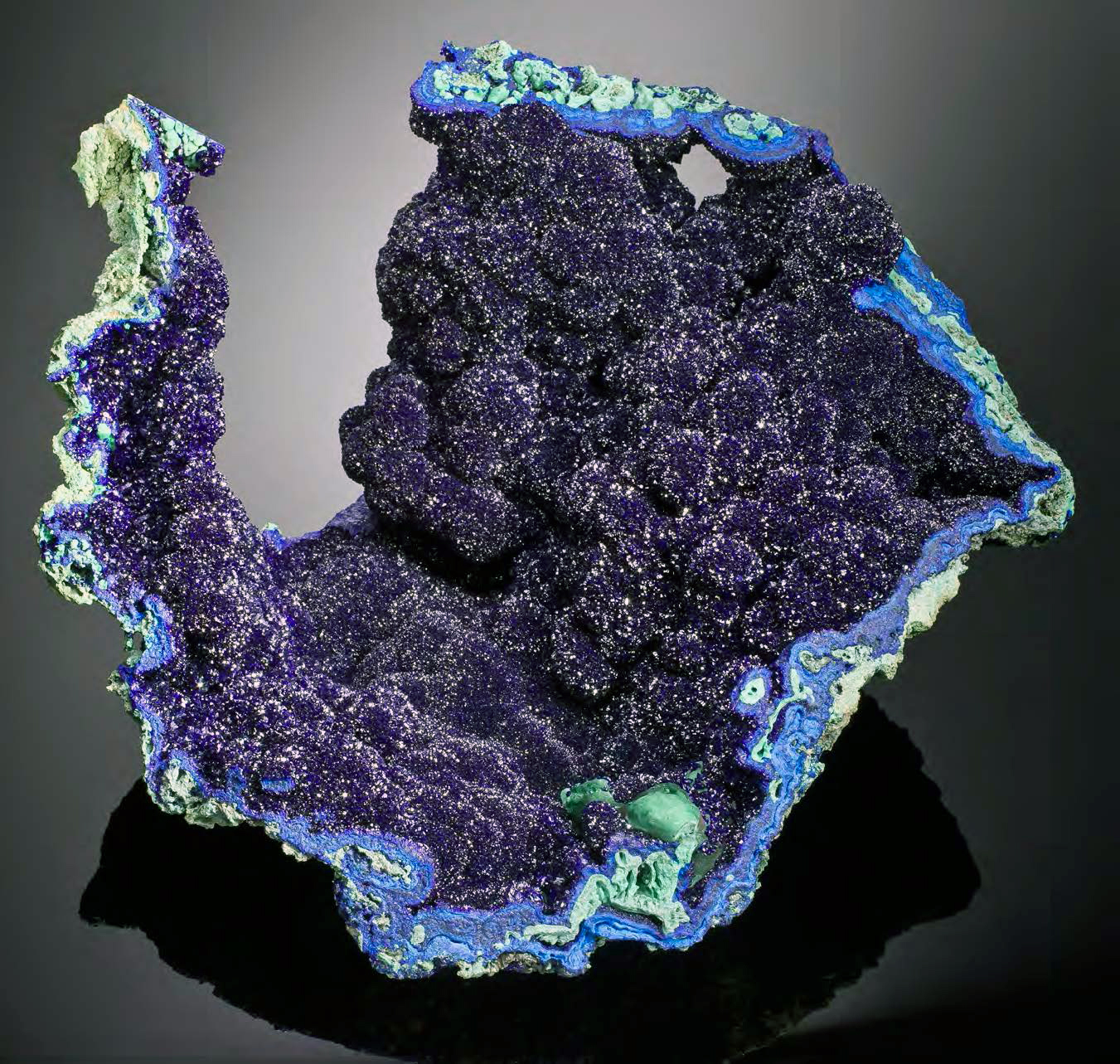
What was your biggest takeaway from this experience? Final thoughts, messages, etc.
DK: Thinking and imagining along a new path toward a shared goal with colleagues and friends should happen more often. Can we design or happen upon more ways to nurture such experiences? At one point in our conversations, Bob Stern used the metaphor of “injuring” gemstones to make them more beautiful—and thereby of greater value (in multiple senses of the term). That comment gave the exhibition an underlying ethical level. We injure the earth when we imagine it as a “source” of economically valuable resources; but we are appalled by the thought of damaging nature’s “stone art” that is magnificently visible—Grand Canyon and Uluru, for example. Should it be equally troubling to injure an underground artisan workshop where unceasing geological forces are creating beauty?
RL: That I can share these treasures I have always felt a visceral, gut-level love for, with others. That other people can see them in association with “real treasures” and come away with the impact of seeing nature’s art on its own, as worthy connoisseur-level collectibles that have a place outside the realm of mere science.
Rare Earth: The Art and Science of Chinese Stones was on view at the Crow Museum of Asian Art of The University of Texas at Dallas through February 26, 2023.